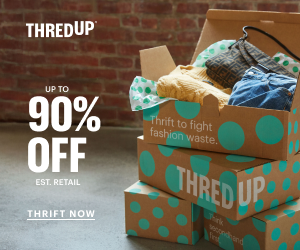Sustainable fashion has been on the rise for over a decade, and in recent years, more consumers have been looking for ways to shop smarter, spend less, and reduce their environmental footprint. Enter thredUP, one of the biggest online resale platforms in the world — often called the “largest online consignment and thrift store.”
With its vast inventory, attractive pricing, and green mission, thredUP.com has become a go-to destination for millions of shoppers who want affordable fashion without supporting fast fashion’s wasteful practices.
But as a blogger who has personally tried and tested many resale and thrift platforms over the years, I wanted to dig deeper and answer some key questions:
Does thredUP really deliver on its promises? Is the shopping experience smooth? And most importantly — is it worth your time and money?
Below is my in-depth review of thredUP, based on weeks of browsing, buying, selling, and researching this ambitious platform.
What is thredUP?
Founded in 2009 by James Reinhart, Chris Homer, and Oliver Lubin, thredUP started as an idea to help people swap high-quality secondhand clothing online. Over time, it evolved into a full-fledged online consignment and thrift shop — allowing users to both buy and sell used clothing, shoes, and accessories.
Headquartered in Oakland, California, thredUP describes itself as a “managed marketplace.” That means they take care of sorting, photographing, listing, pricing, and shipping the clothes, instead of users having to negotiate or sell items peer-to-peer.
The company’s mission is clear: to inspire a new generation of consumers to think secondhand first. On their site, they highlight impressive environmental impact stats, showing how shopping secondhand saves water, energy, and reduces textile waste.
thredUP is now publicly traded, has processed over 100 million pieces of clothing, and partners with major retailers like Macy’s, Tommy Hilfiger, and Walmart to power their resale initiatives.
But does its scale and ambition translate to a great experience for customers? Let’s find out.
First Impressions: Website & Design
As a blogger who spends a lot of time online, the first thing I notice about any brand is their website design and user experience.
Clean and Easy to Navigate
thredUP.com is bright, colorful, and easy to navigate. Categories are clearly laid out at the top — Women, Kids, Handbags, Shoes, Premium Brands, Maternity, and so on.
You can also shop by size, brand, style, occasion, or even search for specific items. Their filtering tools are impressive and help you narrow down a sea of options to just what you’re looking for. For example, you can filter by condition (New with Tags, Like New, Gently Used), color, price range, or material.
The site also feels mobile-friendly — browsing and shopping on my phone was seamless.
The Shopping Experience
Let’s talk about the actual process of shopping on thredUP.
Selection
thredUP boasts one of the largest online selections of secondhand clothing. At any given moment, there are millions of items available — from budget brands like Old Navy and H&M, to premium and designer labels like Tory Burch, Theory, and even Gucci or Chanel in the Luxe section.
The breadth of choice can be overwhelming at first, but if you know what you’re looking for (or love to browse), it’s a treasure trove.
Prices
Prices are where thredUP really shines. Depending on the brand and condition, you can find pieces for 50-90% off retail prices. In my experience:
- Budget brands: often as low as $5–$10 for tops and dresses.
- Premium brands: often 60–80% off retail.
- Luxe/Designer: still pricey, but much more affordable than new.
I picked up a Madewell denim jacket for $24 (retail price: ~$110) and a J.Crew wool coat for under $60 (retail price: ~$250) — both in excellent condition.
Condition of Items
thredUP categorizes clothing by condition, which I found accurate in most cases:
- New with Tags (NWT): Truly brand-new, just as described.
- Like New: Gently worn, with no visible flaws.
- Gently Used: Minor wear, but still perfectly wearable.
Of the 8 items I purchased, 7 were in great condition, but one sweater arrived with a faint stain that hadn’t been mentioned. Not a dealbreaker, but worth noting.
Selling on thredUP
One of the platform’s biggest draws is that you can also sell your unwanted clothes through them.
The Clean Out Bag
Selling starts by ordering a Clean Out Kit: thredUP sends you a large, prepaid bag. You fill it with your clothes and drop it off at a post office or UPS location. Alternatively, you can print a shipping label and use your own box.
The Process
Once they receive your bag, their team sorts through your clothes, photographs and lists the items they accept, and donates or recycles what they don’t.
Here’s the catch: not everything you send will be accepted. thredUP has strict criteria — they only take items in excellent condition and styles that are currently in demand.
Payouts
When your items sell, you earn a small percentage of the selling price. The commission rate varies depending on the price of the item:
- Items under $20: you earn about 5–10%.
- Items over $100: you keep 60–80%.
For example, I sent in 20 items. They accepted 12, and after everything sold, I earned about $38 total — which felt low compared to what I might earn selling on platforms like Poshmark or eBay.
In short, selling on thredUP is convenient but not lucrative. It’s better suited if you want to declutter quickly without much hassle, rather than maximize your earnings.
Sustainability & Impact
One of the biggest reasons I tried thredUP was their environmental mission. According to their website:
- Buying secondhand displaces the need to produce new clothing.
- The average Clean Out Bag saves ~19 lbs of CO2 emissions.
- Shopping secondhand reduces water usage, chemicals, and textile waste.
They also produce an annual Resale Report showing trends in secondhand fashion and its environmental impact.
As someone who cares about sustainable living, I appreciated knowing that my purchases (and donations) were helping reduce fashion waste.
Customer Service
Customer service can make or break an experience. Here’s what I found with thredUP.
Returns
Not all items are eligible for free returns. Items labeled “Final Sale” cannot be returned, while others can be returned for a small restocking fee. You have 14 days from delivery to initiate a return.
I returned one skirt that didn’t fit and found the process simple, though I lost about $3.99 in fees.
Support
thredUP offers email and chat support. Response times were decent (about 24–48 hours), and the support agents were polite and helpful.
Pros & Cons of thredUP
After weeks of using the site, here’s my honest assessment.
Pros
✅ Huge selection of affordable clothing.
✅ Easy-to-use website with great filters.
✅ Significant discounts on premium and designer brands.
✅ Convenient way to sell unwanted clothes.
✅ Helps reduce environmental impact.
✅ Mobile-friendly and reliable shipping.
Cons
🚫 Selling payouts are low compared to other platforms.
🚫 Some items arrive with minor flaws not listed.
🚫 Returns are not always free and have restocking fees.
🚫 Not all Clean Out Bag items are accepted — and you don’t get them back.
🚫 Final Sale items can’t be returned.
How Does thredUP Compare to Other Resale Platforms?
If you’re deciding between thredUP and competitors like Poshmark, Depop, or The RealReal, here’s how thredUP stacks up:
| Feature | thredUP | Poshmark | Depop | The RealReal |
|---|---|---|---|---|
| Best For | Convenience & large inventory | Higher earnings & control | Trendy, vintage finds | Luxury resale |
| Ease of Selling | Very easy | Moderate | Moderate | Easy |
| Earnings | Low | Higher | Moderate | Higher for luxury |
| Returns | Allowed w/ fees | Buyer pays | Buyer pays | Allowed |
| Sustainability | High emphasis | Some | Some | High |
If you want maximum earnings, consider selling elsewhere. But if you value ease, speed, and eco-consciousness, thredUP is hard to beat.
Tips for Using thredUP
Here are a few tips I learned to get the most out of the platform:
- Shop during sitewide sales or use promo codes to save even more.
- Check the Luxe section for hidden designer gems.
- Read item descriptions carefully for condition notes.
- Be realistic about what they’ll accept when sending a Clean Out Bag — stick to in-season, trendy, well-kept items.
- Use filters liberally to narrow your search and avoid feeling overwhelmed.
Final Verdict: Is thredUP Worth It?
If you’re looking for an affordable, convenient, and sustainable way to refresh your wardrobe, thredUP is absolutely worth trying.
It’s not perfect — the returns policy and seller payouts leave room for improvement — but the sheer scale, ease of use, and eco-friendly mission make it one of the best online thrift stores available.
For buyers, it’s a treasure hunt that can save you hundreds of dollars while reducing your fashion footprint. For sellers, it’s a quick and painless way to clear out your closet.
I’d recommend thredUP to:
✨ Budget-conscious shoppers
✨ Sustainable fashion advocates
✨ Busy people who want to declutter with minimal effort
✨ Bargain hunters looking for premium brands at a discount
Best For:
🎯 Buyers looking for affordable secondhand clothing.
🎯 Sellers who value convenience over high payouts.
🎯 Eco-conscious shoppers who want to shop sustainably.
Final Rating: ⭐⭐⭐⭐☆ (4/5)
thredUP combines affordability, convenience, and a green mission in one impressive package. Whether you’re buying or selling, it’s an excellent place to start your secondhand journey.


